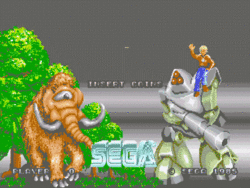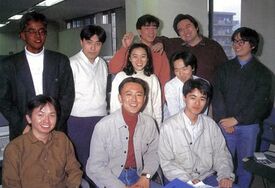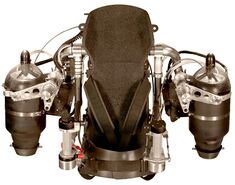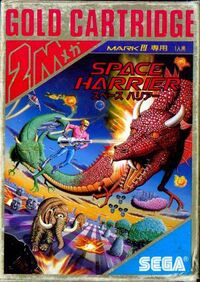Space Harrier
Space Harrier is a coin-operated (coin-op) arcade game designed and developed by Yu Suzuki and AM2 and released by Sega in 1985. The game is an outlandish and psychedelic trip into a strange and colorful planet inhabited by little furry creatures, all of them trying to kill you. A bit like going to Barbados, sans the beach.
Often cited alongside Suzuki’s other arcade classics Hang On, After Burner, and Out Run, Space Harrier is the first and most technologically important game of AM2's "SKAG succession", and is famed for being the first video game in history to be directly inspired by the events of World War 2.
Gameplay
You play as "Franklin", a human man who has flown to another galaxy in order to exterminate all life on the alien planet known as Hirohito. Wielding a plasma rifle with unlimited ammunition, the aim of the game is to shoot down as many enemies as possible and build the highest score on the leader board. Franklin is able to fly, mainly because he went to Neverland and also because he owns a jetpack. The gameplay alludes to mass genocide and champions a nihilistic and apocalytipc world view, as it forces the player to kill absolutely everything in sight. That includes the cute and friendly one-eyed elephant, which is now extinct because of this game. "What would you do if you ever met a one-eyed elephant?" one game designer asked another. "Shoot it" the other said.
The game begins with the iconic statement: "Welcome to the fantasy zone! Get ready!" and from that moment it's a non-stop massacre against all intelligent life on planet Hirohito. Un-intelligent life as well, as even bushes and random critters gets it. The game is highly surreal in nature, and the game visually looks like a mix between a Salvador Dalí painting and the space tunnel in 2001: A Space Odyssey. The overall game experience is one big acid trip, and the end sequence lets you ride on a big furry worm creature, flying through space, high as a kite.
Controls
Controlling Franklin is simplistic. He can be guided in eight different directions by placing the palm of the hand on the nob of the joystick and jerking it about vigorously. In mid-flight you fire his plasma rifle by rapidly pushing the Red Button. Preempting destruction, Sega had the joystick and Red Button cast from luxury-carbonite; a hardy material developed by NASA in the '60s, to ensure that even after one million big presses, and all the sweat that brings, the Red Button would retain its springiness. Due to the speed and erratic nature of the gameplay, complaints of Space Harrier causing RSI (sometimes called "wanker’s wrist") are common.
Innovation
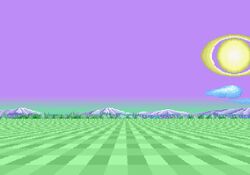
Space Harrier is credited with a list of groundbreaking gaming achievements, such as being the the first 3D game ever created; the first game to feature a life-like human; and the first game to feature in-game music written by a true AI. Many developers would go on to try and emulate Sega’s Super SKAG technology with varying degrees of success.
Due to the advanced nature of Super SKAG and the convoluted design of the cabinets which hosted the game, Sega had to design special "Space Harrier Power Units" (SHPUs) to deliver the power required to run Space Harrier in the arcades. The extreme amount of power required generated so much heat that despite Sega installing industrial fans to cool both the CPU board and the SHPU, the cabinets themselves sometimes melted with the player trapped inside. Reports of some players in Japan suffering radiation burns akin to the Nagasaki heatwave of 1945 were recorded in Sega Magazine (Issue 23, 1986).
Coin-op
The coin-op machine itself, like the game, is credited with revolutionizing '80s arcade palaces by being the first machine to introduce a Red Button to accompany the already familiar joystick. Before Space Harrier, most games required the player to move a 2D object from one side of the screen to the other in order to progress through the game. Examples of such games include Namco’s Dung Heap and Atari's Space Invaders. To control a character flying through the air in a fully realized photo-realistic 3D environment, superior and more articulate controls, better than anything that had come before, were required to experience the game as AM2 intended. There were two versions of the coin-op designed and released in the arcades, though only one version was seen outside of Japan.
Space Harrier Deluxe (SPD1985)
This was the core arcade cabinet shipped worldwide. At a cost of around $12,000 each, Sega produced 50,000 monoliths and shipped 20,000 to the U.S. alone. Featuring an endlessly springy button, luxury joystick, and monstrous 14" monitor to enjoy, the Space Harrier Deluxe was both an exciting curio and modern marvel in the arcades.
Super-Hydraulic Space Harrier Mong-Unit (SHSHMU1985)
This Japan-only arcade machine was a huge hit in the arcades. Though it cost Sega ¥70,000,000 ($700,000) per unit, making it near-impossible to make a profit on, the publicity and extravagance of the machine propelled Sega into the public eye helping to provide some much-needed exposure for the company. Unusually for an arcade machine, it didn’t have a coin or note slot. An attendant, employed by Sega, would stand by the machine and accept ¥1500 per credit from the player. Once the transaction was made, the player was lead into the Harrier Chamber and fitted into an elasticated harness ready for take-off. Once secure the attendant would leave the chamber, set off the warning klaxon, then activate the game.
Due to the weight of the SHSHMU, specially-built rigs had to be constructed to support its heft. Some machines were too big even for the arcade palaces in Japan and were assembled in larger venues such a concert halls, disused warehouses, and airport hangers.
Development
Conception
Sega’s "Super SKAG" technology was developed alongside the production of Space Harrier. Suzuki’s vision of an "into-your-face" game had never been thought of before, and so the technology to deliver such an experience didn’t yet exist. When Suzuki originally proposed the idea of creating a new kind of experience in video gaming, he was ridiculed by his team at AM2:
| “ | They had no idea what I was talking about. The idea that a video game could have more than two dimensions was too much for them to grasp. Nincompoops. Here I was suggesting not only that we could develop the software to create a game in three dimensions, but potentially in four dimensions too. Arcade games such as Pac-Man, Pong, Ping, and Whiff were popular but didn’t push the genre forwards. I wanted to change how we play games. I wanted to make a large impact on the industry. | ” |
Following a weekend on the sake, Suzuki tried a different approach to convince his team that he was right:
| “ | I had a cup of warm sake, pulled my trolleys up, and went in to the lead development team and just said; 'I’m the fucking boss you bunch of bellends, and this is what we’re doing. 3-fucking-D. Space-fucking-Harrier. If you don’t like it, get your clogs off and disappear out of my department!' | ” |
Yu Suzuki, with support from Hiroshi Kataoka, went on to lead the AM2 team in the development and design of the game, and three years later Space Harrier would be released in Japan, Europe, and the U.S. to universal critical acclaim.
Design inspiration
Harrier's design and development was heavily inspired by Suzuki’s own childhood. During the Second World War, a young Suzuki witnessed the Allied Forces invade then ignite his his hometown of Kamaishi. This left an indelible mark on him and has influenced his life and career since. In an interview with Sega Magazine in 1987, Suzuki explained to journalist Richard Leadbetter of the inspiration behind Space Harrier:
| “ | For me, coming to terms with these images and these horrible acts of violence and destruction was essential. Many of my friends died that day and the memories still haunt me. I distinctly remember by friend Tetsuo getting toasted with a plasma rifle… he hovered then just puffed into a pile of ashes right in front of me. It’s important that I share some of these memories with today’s children so they can understand what it was like in Japan back in 1945. | ” |
During the extensive interview, Suzuki also discussed why he chose the name Space Harrier and how it also linked to his past:
| “ | I wanted to use words which perfectly described invaders who engage in constant barbaric violence… but didn't want to discourage the player from engaging. I needed to move the idea away from the horrors of World War 2 and give it a new setting. Before I saw those jet-packs in Kamaishi I’d only ever dreamed of such a technology being a reality, it was still pure fantasy to me. It felt like science and technology had somehow changed the rules of war, even changed the way we look at life… and they’d been changed to suit the Americans and their allies not us.
That's when the idea came to me. I thought; if I set Space Harrier in a science fiction setting, featuring a xenophobic white European male flying around on a jet-pack equipped with a laser rifle, aggressive and barbaric ready to destroy his enemies, it’d appeal to the western market. After all, that’s what their forefathers did for real in the '40s. |
” |
Music
The music of Space Harrier was a departure from what gamers were used to in 1985. Gone were the blips and pings of games such as Galaga and Wheely Wogs and in came music written by Sega's AI-451 capable of replicating multi-textural sounds rivaling those of contemporary musicians such as Noel Pointer, Kraftwerk, Depeche Mode and Luther Vandross. The game's soundtrack was quite addictive, and some players would pop more coins in the machines simply to hear more. Today, the soundtrack has been singled out as one the best game soundtracks of the 1980s. Mostly because all the other game music at the time was demented and musically inept noise.
The entire soundtrack was programmed on a pocket calculator by the game designer's 10-year-old nephew. It somehow mixes disco with electronic music, making you dance while you play.
- Space Harrier Original Soundtrack
- "Space Harrier Main Title" (Level 1 theme) – 0:22
- "Ras Clarts" (Level 2 theme) – 2:02
- "Kamikaze Dreams" (Level 3/5/6 Theme) – 1:53
- "Paradoxical Events" (Level 4 theme) – 3:04
- "End Credits" (End level theme) – 0:03
Home conversions
Very few versions of Harrier were ported to home consoles in the following years after its arcade debut. This is in part due to most home consoles being incapable of running the Super SKAG system without a SHPU, but also due to Sega’s paranoia of Nintendo having access to the technology. By the time Nintendo finally released a competitor to the Super SKAG system in the form of Pilotwings, Sega had moved on and was utilizing its arcade ConDOM boards.
- Sega Pimlico (1990) – Successfully ported to cartridge by AM2 with only minor changes. A technical marvel for its time, the Sega Pimlico version of Harrier is the best-selling version of the home console conversions. Technical bit-rates: Reduced color palette, soundtrack reduced to one single track of music, replacement of various sound effects. Sales pip-rates: RRP price: $40.00. Total global units sold: 215,213.
- Super Drive CDX (1994) – Ported by Sonic Team as part of Sega's infamous 3 SKAGs in a Bag promotion. A rare three-game disc of Out Run, After Burner, and Space Harrier. The disc compilation was released in a clear plastic bag complete with lighter and teaspoon. Technical blip-rates: Framerate drops from 60fps to 3fps on level 2. Sales nip-rates: RRP price: $50.00. Total global units sold: 114,784.
- Sega Saturn (1997) – Ported by the AM4 division of Sega's AM3 division under Yu Suzuki’s AM2 division. Regarded as the quintessential home version of Space Harrier, it came specially packed with a miniaturized SHPU power brick to support the conversion. Technical ship-rates: Improved framerate (up to 127fps). Sale snip-rates: RRP price: $39.99. Total global units sold: 3.
Reception
Space Harrier received praise for its non-stop action, bright colors, and overall weirdness. It was one of the first video games to receive any praise at all, as video game critics in the mid-1980s were limited to writing things like "Um, you control this little yellow dude who eats little dots, while being chased by ghosts, and that's the whole game." As this game was slightly more complex, video game critics actually had something to say about it. Many critics noted the new 3D feeling, which was something very new in video gaming. The feeling of several monsters coming towards you sent some critics in panic, as they believed the monsters were real and ran away from the arcade machines as fast as they could. They would hide in corners, crouching with their heads in their hands. "They're real, they're real" they would repeat to themselves. It would take several skilled therapists to bring them back to their rational selves — but it was too late. The newspapers and magazines would run headlines warning against the impending doom. "Evil monsters attack earth" and "Earth is powerless against the hordes of aliens coming out of an arcade machine" were two examples of this.
More than thirty years after its invention, Space Harrier continues to amaze video gamers with its addictive gameplay, fast-paced action, and wacky visual style. Which says a lot about the poor quality of video games: You have to go back to 1985 to find a decent game to play.
See also
| Featured version: 26 June 2017 | |
| This article has been featured on the main page. — You can vote for or nominate your favourite articles at Uncyclopedia:VFH. | |
